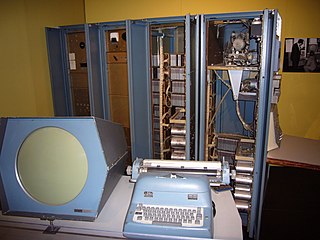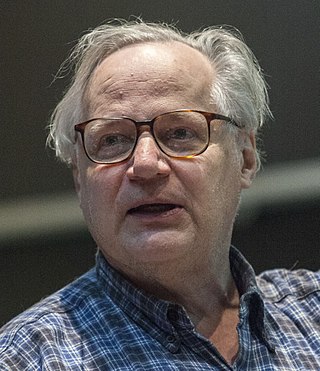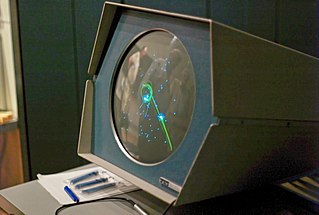Related Research Articles

Programmed Data Processor (PDP), referred to by some customers, media and authors as "Programmable Data Processor," is a term used by the Digital Equipment Corporation from 1957 to 1990 for several lines of minicomputers.

The PDP-1 is the first computer in Digital Equipment Corporation's PDP series and was first produced in 1959. It is famous for being the most important computer in the creation of hacker culture at the Massachusetts Institute of Technology, Bolt, Beranek and Newman and elsewhere. The PDP-1 is the original hardware for playing history's first game on a minicomputer, Steve Russell's Spacewar!
TECO, short for Text Editor & Corrector, is both a character-oriented text editor and a programming language, that was developed in 1962 for use on Digital Equipment Corporation computers, and has since become available on PCs and Unix. Dan Murphy developed TECO while a student at the Massachusetts Institute of Technology (MIT).

The LINC is a 12-bit, 2048-word transistorized computer. The LINC is considered by some to be the first minicomputer and a forerunner to the personal computer. Originally named the Linc, suggesting the project's origins at MIT's Lincoln Laboratory, it was renamed LINC after the project moved from the Lincoln Laboratory. The LINC was designed by Wesley A. Clark and Charles Molnar.

The TX-0, for Transistorized Experimental computer zero, but affectionately referred to as tixo, was an early fully transistorized computer and contained a then-huge 64K of 18-bit words of magnetic-core memory. Construction of the TX-0 began in 1955 and ended in 1956. It was used continually through the 1960s at MIT. The TX-0 incorporated around 3,600 Philco high-frequency surface-barrier transistors, the first transistor suitable for high-speed computers. The TX-0 and its direct descendant, the original PDP-1, were platforms for pioneering computer research and the development of what would later be called computer "hacker" culture. For MIT, this was the first computer to provide a system console which allowed for direct interaction, as opposed to previous computers, which required the use of punched card as a primary interface for programmers debugging their programs. Members of MIT's Tech Model Railroad Club, "the very first hackers at MIT", reveled in the interactivity afforded by the console, and were recruited by Marvin Minsky to work on this and other systems used by Minsky's AI group.

The Tech Model Railroad Club (TMRC) is a student organization at the Massachusetts Institute of Technology (MIT). Historically, it has been a wellspring of hacker culture and the oldest such hacking group in North America. Formed in 1946, its HO scale layout specializes in the automated operation of model trains.

Richard D. Greenblatt is an American computer programmer. Along with Bill Gosper, he may be considered to have founded the hacker community, and holds a place of distinction in the communities of the programming language Lisp and of the Massachusetts Institute of Technology (MIT) Artificial Intelligence Laboratory.

Expensive Typewriter was a pioneering text editor program that ran on the DEC PDP-1 computer, which had been delivered to MIT in the early 1960s.
The PDP-5 was Digital Equipment Corporation's first 12-bit computer, introduced in 1963.

Thomas Greenway Stockham was an American scientist who developed one of the first practical digital audio recording systems, and pioneered techniques for digital audio recording and processing. He also led the development of the Digital Audio Tape (DAT) system.

Friden Calculating Machine Company was an American manufacturer of typewriters and mechanical, later electronic calculators. It was founded by Carl Friden in San Leandro, California, in 1934.
Mac Hack is a computer chess program written by Richard D. Greenblatt. Also known as Mac Hac and The Greenblatt Chess Program, it was developed at the Massachusetts Institute of Technology. Mac Hack VI was the first chess program to play in human tournament conditions, the first to be granted a chess rating, and the first to win against a person in tournament play. A pseudocode for the program is given in Figure 11.16 of.

Alan Kotok was an American computer scientist known for his work at Digital Equipment Corporation and at the World Wide Web Consortium (W3C). Steven Levy, in his book Hackers: Heroes of the Computer Revolution, describes Kotok and his classmates at the Massachusetts Institute of Technology (MIT) as the first true hackers.

Spacewar! is a space combat video game developed in 1962 by Steve Russell in collaboration with Martin Graetz, Wayne Wiitanen, Bob Saunders, Steve Piner, and others. It was written for the newly installed DEC PDP-1 minicomputer at the Massachusetts Institute of Technology. After its initial creation, Spacewar! was expanded further by other students and employees of universities in the area, including Dan Edwards and Peter Samson. It was also spread to many of the few dozen installations of the PDP-1 computer, making Spacewar! the first known video game to be played at multiple computer installations.
Peter R. Samson is an American computer scientist, best known for creating pioneering computer software for the TX-0 and PDP-1.

Expensive Desk Calculator by Robert A. Wagner is thought to be computing's first interactive calculation program.

Colossal Typewriter by John McCarthy and Roland Silver was one of the earliest computer text editors. The program ran on the PDP-1 at Bolt, Beranek and Newman (BBN) by December 1960.
Harmony Compiler was written by Peter Samson at the Massachusetts Institute of Technology (MIT). The compiler was designed to encode music for the PDP-1 and built on an earlier program Samson wrote for the TX-0 computer.
T-Square is an early drafting program written by Peter Samson assisted by Alan Kotok and possibly Robert A. Saunders while they were students at the Massachusetts Institute of Technology and members of the Tech Model Railroad Club.
Robert Alan Saunders was an American computer scientist, most famous for his involvement with Spacewar. Saunders joined the Tech Model Railroad Club (TMRC) led by Alan Kotok, Peter Samson, and himself. They then met Marvin Minsky and other influential pioneers in what was then known as Artificial Intelligence.
References
- Gross, David (1984). "Highlights from The Computer Museum Report Volume 8, Spring 1984". Ed Thelen Web site. Archived from the original on 2006-06-15. Retrieved 2006-06-24.
- Unknown authors (n.d.). "Tixo.org: Hacks: Expensive Tape Recorder". Tixo.org. Archived from the original on April 3, 2005. Retrieved 2006-12-29.